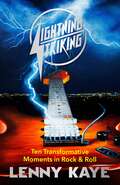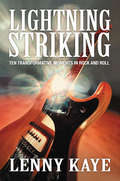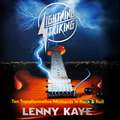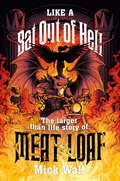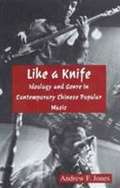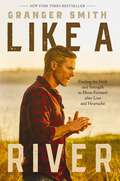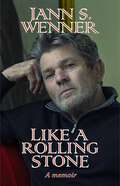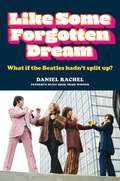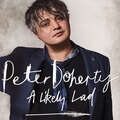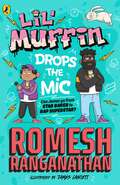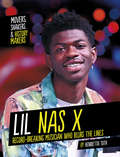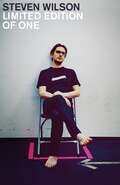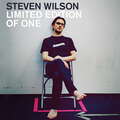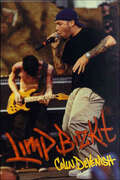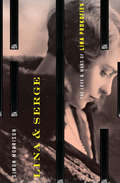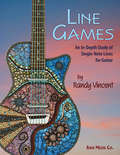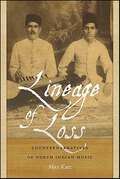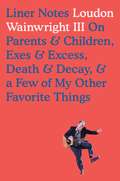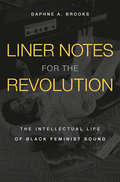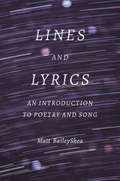- Table View
- List View
The Lightning Bottles: An absolutely gripping and heartbreaking page-turner
by Marissa Stapley'I absolutely loved this book and found myself drawn in and unable to put it down from page one! I can see this being a great pick for anyone who loved Daisy Jones and The Six' Reader review ⭐⭐⭐⭐⭐'I seriously loved this book! It brought together two of my great loves in life, music and books... The characters were out of this world! I felt all of the emotions... What a wonderful story' Reader review ⭐⭐⭐⭐⭐He was the troubled face of rock 'n' roll . . . until he disappeared without a trace...Jane Pyre was once half of the famous rock 'n' roll duo, the Lightning Bottles. Years later, she's perhaps the most hated-and least understood-woman in music. She was never as popular with fans as her bandmate (and soulmate), Elijah Hart - even if Jane was the one who wrote the songs that catapulted the Lightning Bottles to instant, dizzying fame, first in the Seattle grunge scene, then around the world.But ever since Elijah disappeared five years earlier and the band's meteoric rise to fame came crashing down, the public hatred of Jane has taken on new levels, and all she wants to do is retreat. What she doesn't anticipate is the bombshell that awaits her at her new home in the German countryside: the sullen teenaged girl next door-a Lightning Bottles superfan-who claims to have proof that not only is Elijah still alive, he's also been leaving secret messages for Jane. And they need to find them right away...Combining a mystery, a love story and a coming of age, this unforgettable novel is perfect for fans of Taylor Jenkins Reid, The Idea of You and Songs in Ursa Major - and will have you hooked from the very first page! Everyone loves The Lightning Bottles: 'If you enjoy rock n roll love stories and Daisy Jones and The Six you will really like this book. I absolutely could not put it down!... A great summer read' Reader review ⭐⭐⭐⭐⭐'Wow - I absolutely loved this... 5 stars!' Reader review ⭐⭐⭐⭐⭐'I wish I could give this book 10 stars! From the very start of Elijah and Jane's relationship, I was absolutely hooked' Reader review ⭐⭐⭐⭐⭐'WOW. I could not put this book down. I loved the grunge, rock & roll, music feel of this book... I read this book in 2 days' Reader review ⭐⭐⭐⭐⭐'A book that you can't put down!!' Reader review ⭐⭐⭐⭐⭐'Wow, this was such a great book! I loved both Jane and Elijah and thought their love story was inspiring' Reader review ⭐⭐⭐⭐⭐
Lightning Striking
by Lenny Kaye'A true testimonial and epic love letter to the soul saving power of rock & roll . . . Read it and be inspired, as I was' Bobby Gillespie'Lenny Kaye has illuminated ten facets of the jewel called rock and roll from a uniquely personal and knowledgeable perspective. He draws from a lifetime of inspiration and experience. A youth plugging in his first electric guitar, a fan taking the dance floor, a propelling player, a humble guardian of history, and the writer I have always known him to be' Patti SmithMemphis, 1954. New Orleans 1957. Philadelphia 1959. Liverpool, 1962. San Francisco 1967. Detroit 1969. New York, 1975. London 1977. Los Angeles 1984 / Norway 1993. Seattle 1991.Rock and roll was birthed in basements and garages, radio stations and dance halls, in cities where unexpected gatherings of artists and audience changed and charged the way music is heard and celebrated, capturing lightning in a bottle. Musician and writer Lenny Kaye explores ten crossroads of time and place that define rock and roll, its unforgettable flashpoints, characters and visionaries, how each generation came to be, how it was discovered by the world. Whether Elvis Presley's Memphis, the Beatles' Liverpool, Patti Smith's New York or Kurt Cobain's Seattle, LIGHTNING STRIKING reveals the communal energy that creates a scene, a guided tour inside style and performance, to see who's on stage, along with the movers and shakers, the hustlers and hangers-on, and why everybody is listening. Grandly sweeping and minutely detailed, informed by Kaye's acclaimed knowledge and experience as a working musician, LIGHTNING STRIKING is an ear-opening insight into our shared musical and cultural history, a carpet ride of rock and roll's most influential movements and moments.
Lightning Striking: Ten Transformative Moments in Rock and Roll
by Lenny Kaye“We have performed side-by-side on the global stage through half a century…. In Lightning Striking, Lenny Kaye has illuminated ten facets of the jewel called rock and roll from a uniquely personal and knowledgeable perspective.” –Patti SmithAn insider’s take on the evolution and enduring legacy of the music that rocked the twentieth centuryMemphis, 1954. New Orleans 1957. Philadelphia 1959. Liverpool, 1962. San Francisco 1967. Detroit 1969. New York, 1975. London 1977. Los Angeles 1984 / Norway 1993. Seattle 1991.Rock and roll was birthed in basements and garages, radio stations and dance halls, in cities where unexpected gatherings of artists and audience changed and charged the way music is heard and celebrated, capturing lightning in a bottle. Musician and writer Lenny Kaye explores ten crossroads of time and place that define rock and roll, its unforgettable flashpoints, characters and visionaries, how each generation came to be, how it was discovered by the world. Whether describing Elvis Presley’s Memphis, the Beatles’ Liverpool, Patti Smith’s New York or Kurt Cobain’s Seattle, Lightning Striking reveals the communal energy that creates a scene, a guided tour inside style and performance, to see who’s on stage, along with the movers and shakers, the hustlers and hangers-on, and why everybody is listening. Grandly sweeping and minutely detailed, informed by Kaye’s acclaimed knowledge and experience as a working musician, Lightning Striking is an ear-opening insight into our shared musical and cultural history, a carpet ride of rock and roll’s most influential movements and moments.
Lightning Striking
by Lenny KayeMemphis, 1954. New Orleans 1957. Philadelphia 1959. Liverpool, 1962. San Francisco 1967. Detroit 1969. New York, 1975. London 1977. Los Angeles 1984 / Norway 1993. Seattle 1991. <p><p>Rock and roll was birthed in basements and garages, radio stations and dance halls, in cities where unexpected gatherings of artists and audience changed and charged the way music is heard and celebrated, capturing lightning in a bottle. Musician and writer Lenny Kaye explores ten crossroads of time and place that define rock and roll, its unforgettable flashpoints, characters and visionaries, how each generation came to be, how it was discovered by the world. <p><p>Whether Elvis Presley's Memphis, the Beatles' Liverpool, Patti Smith's New York or Kurt Cobain's Seattle, LIGHTNING STRIKING reveals the communal energy that creates a scene, a guided tour inside style and performance, to see who's on stage, along with the movers and shakers, the hustlers and hangers-on, and why everybody is listening. Grandly sweeping and minutely detailed, informed by Kaye's acclaimed knowledge and experience as a working musician, LIGHTNING STRIKING is an ear-opening insight into our shared musical and cultural history, a carpet ride of rock and roll's most influential movements and moments.
Like a Bat Out of Hell: The Larger than Life Story of Meat Loaf
by Mick Wall'A passionate, pacey tome you should do anything for a copy of' - Kerrang! ****"I never wanted to be a big star. I just wanted to be the biggest at what I do! Powerful, unstoppable, heavy - when that word still meant something good!" - Meat Loaf, as told to Mick Wall Everything in the story of Meat Loaf is big. From the place he was born (Texas); to the family he was born into (his father weighed 22 stone, his uncle weighed over 40 stone, while Meat Loaf himself weighed 17 stone before he was even in his teens); to the sound he made (a colossal collision between Richard Wagner, Phil Spector and Bruce Springsteen); and of course the records he sold - nearly 50 million in Britain and America alone. Now, on the eve of the 40th anniversary of Bat Out of Hell, the album that gave rise to Meat Loaf's astonishing career, and the premiere of Bat Out Of Hell: The Musical, Mick Wall, who has interviewed Meat Loaf on numerous occasions throughout his career, pulls back the curtains to reveal the soft-hearted soul behind the larger-than-life character he created for himself. From a tumultuous childhood with an alcoholic father to the relentless abusive bullying from classmates and their parents alike, nobody could have predicted Meat Loaf's meteoric rise to fame. But when the messianic rock opera Bat Out of Hell was released in 1977, it became one of the biggest albums of all time, selling over 45 million copies worldwide to date. Its release marked the start of a rollercoaster ride of incredible highs and seemingly career-ending lows. By the 80s, Meat Loaf was battling with drug and alcohol addiction and escalating money problems that would eventually lead to a nervous breakdown. But just when it seemed like it was all over, the astonishing success of Bat Out of Hell II and the mega-hit 'I'd Do Anything For Love (But I Won't Do That)' marked an extraordinary new wave of success. Now, Mick Wall will bring this extraordinary story up to date, drawing on the hours he spent with Meat Loaf, both in interviews and on tour, as well as offering up a unique insight from those who have known him best.
Like a Bat Out of Hell: The Larger than Life Story of Meat Loaf
by Mick Wall'A passionate, pacey tome you should do anything for a copy of' - Kerrang! "I never wanted to be a big star. I just wanted to be the biggest at what I do! Powerful, unstoppable, heavy - when that word still meant something good!" - Meat Loaf, as told to Mick Wall Everything in the story of Meat Loaf is big. From the place he was born (Texas); to the family he was born into (his father weighed 22 stone, his uncle weighed over 40 stone, while Meat Loaf himself weighed 17 stone before he was even in his teens); to the sound he made (a colossal collision between Richard Wagner, Phil Spector and Bruce Springsteen); and of course the records he sold - nearly 50 million in Britain and America alone.From a tumultuous childhood with an alcoholic father to the relentless abusive bullying he endured, nobody could have predicted Meat Loaf's meteoric rise to fame. But when the messianic rock opera Bat Out of Hell was released in 1977, it became one of the biggest albums of all time, selling over 45 million copies worldwide to date. Its release marked the start of a rollercoaster ride of incredible highs and seemingly career-ending lows. By the 80s, Meat Loaf was battling with drug and alcohol addiction and escalating money problems. But just when it seemed like it was all over, the astonishing success of Bat Out of Hell II and the mega-hit 'I'd Do Anything For Love (But I Won't Do That)' marked an extraordinary new wave of success. Now, Mick Wall will bring this extraordinary story up to date, drawing on the hours he spent with Meat Loaf, both in interviews and on tour, as well as offering up a unique insight from those who have known him best.
Like a Knife: Ideology and Genre in Contemporary Chinese Popular Music
by Andrew F. JonesLike a Knife is the first comprehensive study of Chinese popular music in Western language. Drawing on extensive interviews with singers, songwriters and critics, as well as cultural, sociological, musical, and textual analysis, the book portrays the disparate ways in which China's state-run popular music industry and the burgeoning underground rock music subculture represented by Cui Jian have been instrumental to the cultural and political struggles that culminated in the Tiananmen democracy movement of 1989. The book examines the links between popular music and contemporary debates about cultural identity and modernization, as well as the close connections between rock music, youth culture, and student protest.
Like a River: Finding the Faith and Strength to Move Forward after Loss and Heartache
by Granger SmithNew York Times, USA Today, Wall Street Journal, Publishers Weekly, ECPA Bestseller'Country music artist Smith debuts with a sensitive and moving recollection of his path through grief. . .In stark, intimate prose, the author candidly renders the realities of suffering while articulating a moving message of renewal. Those seeking a faith-based path through grief will find this instructive and affecting.' -- Publishers WeeklyLike a River, a triumphant story of new life birthed out of tragedy, will teach readers how to face their failures, confront their pain, and connect with God—the true source of life.On June 4th, 2019, country music singer Granger Smith was enjoying a final evening with his kids before heading to Nashville for the CMT Music Awards and his next tour. While helping his daughter London with her gymnastics, his youngest son fell into their pool. Granger did everything he could to get to him, but he was too late. River drowned, and Granger's world shattered.The days, weeks, and months that followed River's death sent Granger on a dark and painful journey. Every time he closed his eyes, he replayed the horrific event in his mind, and every time he opened his computer, he was bombarded by the critique and criticism of people who blamed him for the accident.Despite his best effort to get back on stage with a smile and song, it was all a façade. On the inside he was dying. Fortunately, that's not how his story ended. And now he is compelled to help people all around the world find strength, peace, and hope on the other side of tragedy.Like a River, life is full of twists and turns.Like a River, people pollute our world with their critique and criticism.Like a River, tragic events keep us dammed up.But like a river, we can find the courage to keep moving downstream. Rivers don't run on their own strength; they flow from their source. When we try to keep going on our own, we won't make it, but when we connect to the greater source, we will find the strength and the faith to keep living after loss. This triumphant story of new life birthed out of death will inspire every reader to live Like a River.
Like a Rolling Stone: A Memoir
by Jann WennerIn this New York Times bestseller, Rolling Stone founder, co-editor, and publisher Jann Wenner offers a "touchingly honest" and "wonderfully deep" memoir from the beating heart of classic rock and roll (Bruce Springsteen). Jann Wenner has been called by his peers &“the greatest editor of his generation.&” His deeply personal memoir vividly describes and brings you inside the music, the politics, and the lifestyle of a generation, an epoch of cultural change that swept America and beyond. The age of rock and roll in an era of consequence, what will be considered one of the great watersheds in modern history. Wenner writes with the clarity of a journalist and an essayist. He takes us into the life and work of Bob Dylan, John Lennon, Mick Jagger, Bono, and Bruce Springsteen, to name a few. He was instrumental in the careers of Hunter S. Thompson, Tom Wolfe, and Annie Leibovitz. His journey took him to the Oval Office with his legendary interviews with Bill Clinton and Barack Obama, leaders to whom Rolling Stone gave its historic, full-throated backing. From Jerry Garcia to the Dalai Lama, Aretha Franklin to Greta Thunberg, the people Wenner chose to be seen and heard in the pages of Rolling Stone tried to change American culture, values, and morality.Like a Rolling Stone is a beautifully written portrait of one man&’s life, and the life of his generation.
Like Some Forgotten Dream: What if the Beatles hadn't split up?
by Daniel Rachel***This is the story of the great lost Beatles album.The end of the Beatles wasn't inevitable. It came through miscommunication, misunderstandings and missed opportunities to reconcile.But what if it didn't end? What if just one of those chances was taken, and the Beatles carried on? What if they made one last, great album?In Like Some Forgotten Dream, Daniel Rachel - winner of the prestigious Penderyn Music Book Prize - looks at what could have been. Drawing on impeccable research, Rachel examines the the Fab Four's untimely demise - and from the ashes compiles a track list for an imagined final album, pulling together unfinished demos, forgotten B-sides, hit solo songs, and arguing that together they form the basis of a lost Beatles masterpiece.Compelling and convincing, Like Some Forgotten Dream is a daring re-write of Beatles history, and a tantalising glimpse of what might have been.Praise for Daniel Rachel:Walls Come Tumbling Down:'Superlative...brilliant' - Q Magazine'Triumphant' - The Guardian'Brilliant' - MojoIsle of Noises:'In depth, scholarly' - Q Magazine'Fascinating' - The Guardian / NME'Fantastic, insightful interviews' - Noel GallagherDon't Look Back in Anger:'A-grade, A-list' - The Sunday Times'A rollicking read' - Mail on Sunday'Remarkable' - Art Review'Book of the Week' - The Guardian
Like Some Forgotten Dream: What if the Beatles hadn't split up?
by Daniel Rachel***This is the story of the great lost Beatles album.The end of the Beatles wasn't inevitable. It came through miscommunication, misunderstandings and missed opportunities to reconcile.But what if it didn't end? What if just one of those chances was taken, and the Beatles carried on? What if they made one last, great album?In Like Some Forgotten Dream, Daniel Rachel - winner of the prestigious Penderyn Music Book Prize - looks at what could have been. Drawing on impeccable research, Rachel examines the the Fab Four's untimely demise - and from the ashes compiles a track list for an imagined final album, pulling together unfinished demos, forgotten B-sides, hit solo songs, and arguing that together they form the basis of a lost Beatles masterpiece.Compelling and convincing, Like Some Forgotten Dream is a daring re-write of Beatles history, and a tantalising glimpse of what might have been.Praise for Daniel Rachel:Walls Come Tumbling Down:'Superlative...brilliant' - Q Magazine'Triumphant' - The Guardian'Brilliant' - MojoIsle of Noises:'In depth, scholarly' - Q Magazine'Fascinating' - The Guardian / NME'Fantastic, insightful interviews' - Noel GallagherDon't Look Back in Anger:'A-grade, A-list' - The Sunday Times'A rollicking read' - Mail on Sunday'Remarkable' - Art Review'Book of the Week' - The Guardian
A Likely Lad
by Peter Doherty Simon SpencePeter Doherty's is the last of the great rock 'n' roll stories - bad boy and public enemy. To his devoted fans, he is a cult hero, a modern-day Rimbaud. Musically, he has defined the past twenty years of indie rock with his sound, lyrics, lifestyle and aesthetic.Since The Libertines rose to international fame, Doherty has proved endlessly fascinating. A whirlwind of controversy and scandal has tailed him ever since the early 2000s, so much so that all too often his talents as a songwriter and performer have been overlooked; for every award and accolade, there is a scathing review. Hard drugs, tiny gigs on the hoof, huge stadium shows, collaborations, obliterations, gangsters and groupies - Doherty has led a life of huge highs and incredible lows.With his wildest days behind him, Doherty candidly explores - with sober and sometimes painful insight - some of his greatest and darkest moments, taking us inside the creative process, decadent parties, substance-fuelled nights, his time in prison and tendency for self-destruction. With his trademark wit and humour, Doherty also details his childhood years, key influences, pre-fame London shenanigans, and reflects on his era-defining relationship with Libertines co-founder Carl Barât and other significant people in his life. There is humour, warmth, insight, baleful reflection and a defiant sense of triumph.A Likely Lad is Doherty's version of the story - the genuine man behind the fame and infamy. This is a rock memoir like no other.
Lil' Muffin Drops the Mic: The brand-new children’s book from comedian Romesh Ranganathan!
by Romesh RanganathanFrom comedy superstar Romesh Ranganathan comes a hilarious and heartfelt tale that proves rap battles and baking muffins really can mix. The perfect story for readers age 8+ and fans of David Baddiel and Adam B Wins the Internet!Ever since his dad left, James can't seem to stop worrying about everything. His favourite hobby, baking, is a fun (and delicious!) distraction, but no matter how many AMAZING brownies he makes, James still feels like there's a missing ingredient in his life . . .Until he discovers rapping, and he's COMPLETELY hooked. It's not long before James starts writing his own raps about everything - from music and cakes to his giant pet rabbit, Graham!So when he hears that grime artist star Brukka is on the hunt for young talent, James starts to wonder: could this be his chance to share his MUFFINS, his MUSIC, and maybe even his feelings with the whole school? If he could only find the confidence . . .Full of laugh-out-loud illustrations from bestselling illustrator James Lancett, this is the children's read of the summer!
Lil Nas X: Record-Breaking Musician Who Blurs the Lines (Movers, Shakers, and History Makers)
by Henrietta TothLil Nas X became famous in 2019 for the country rap song "Old Town Road." He collaborates with other musicians and aims to defy expectations. Learn more about Lil Nas X's life as a famous musician!
Limited Edition of One
by Steven WilsonThe more I thought about it, the more I realised my career has been unusual. How did I manage to do everything wrong but still end up on the front cover of magazines, headlining world tours and achieving Top 5 albums? How did I attract such obsessive and fanatical fans, many of whom take everything I do or say very personally, which is simultaneously flattering but can also be tremendously frustrating? Even this I somehow cultivated without somehow meaning to. My accidental career.Limited Edition of One is unlike any other music book you will ever have read.Part the long-awaited memoir of Steven Wilson: whose celebrated band Porcupine Tree began as teenage fiction before unintentionally evolving into a reality that encompassed Grammy-nominated records and sold-out shows around the world, before he set out for an even more successful solo career.Part the story of a twenty-first century artist who achieved chart-topping mainstream success without ever becoming part of the mainstream. From Abba to Stockhausen, via a collection of conversations and thought pieces on the art of listening, the rules of collaboration, lists of lists, personal stories, professional adventurism (including food, film, TV, modern art), old school rock stardom, how to negotiate an obsessive fanbase and survive on social media, and dream-fever storytelling.
Limited Edition of One
by Steven WilsonThe more I thought about it, the more I realised my career has been unusual. How did I manage to do everything wrong but still end up on the front cover of magazines, headlining world tours and achieving Top 5 albums? How did I attract such obsessive and fanatical fans, many of whom take everything I do or say very personally, which is simultaneously flattering but can also be tremendously frustrating? Even this I somehow cultivated without somehow meaning to. My accidental career.Limited Edition of One is unlike any other music book you will ever have read.Part the long-awaited memoir of Steven Wilson: whose celebrated band Porcupine Tree began as teenage fiction before unintentionally evolving into a reality that encompassed Grammy-nominated records and sold-out shows around the world, before he set out for an even more successful solo career.Part the story of a twenty-first century artist who achieved chart-topping mainstream success without ever becoming part of the mainstream. From Abba to Stockhausen, via a collection of conversations and thought pieces on the art of listening, the rules of collaboration, lists of lists, personal stories, professional adventurism (including food, film, TV, modern art), old school rock stardom, how to negotiate an obsessive fanbase and survive on social media, and dream-fever storytelling.
Limited Edition of One: How to Succeed in the Music Industry Without Being Part of the Mainstream
by Steven WilsonThe more I thought about it, the more I realised my career has been unusual. How did I manage to do everything wrong but still end up on the front cover of magazines, headlining world tours and achieving Top 5 albums? How did I attract such obsessive and fanatical fans, many of whom take everything I do or say very personally, which is simultaneously flattering but can also be tremendously frustrating? Even this I somehow cultivated without somehow meaning to. My accidental career.Limited Edition of One is unlike any other music book you will ever have read.Part the long-awaited memoir of Steven Wilson: whose celebrated band Porcupine Tree began as teenage fiction before unintentionally evolving into a reality that encompassed Grammy-nominated records and sold-out shows around the world, before he set out for an even more successful solo career.Part the story of a twenty-first century artist who achieved chart-topping mainstream success without ever becoming part of the mainstream. From Abba to Stockhausen, via a collection of conversations and thought pieces on the art of listening, the rules of collaboration, lists of lists, personal stories, professional adventurism (including food, film, TV, modern art), old school rock stardom, how to negotiate an obsessive fanbase and survive on social media, and dream-fever storytelling.
Limp Bizkit
by Colin Devenish1999 was quite a year for Limp Bizkit. Their album, "Significant Other," sat atop the Billboard album charts. Rolling Stone hailed them as the lone band that "redefined late-Nineties hard rock." Their Woodstock '99 set is routinely referred to as the hottest moment of the three day concert. All in all, things are definitely happening for this most unique group. Combining rap, metal and the angst filled sentiment of punk rock, Limp Bizkit are the poster-boys for millenium madness.Noted music journalist Colin Devenish goes beyond the chart topping numbers and concert grosses to examine what has turned this rough and tumble bunch from Jacksonville, Florida into the hottest group on the charts.
Lina & Serge: The Love and Wars of Lina Prokofiev
by Simon MorrisonThis account of the renowned composer&’s neglected wife—including her years in a Soviet prison—is &“a story both riveting and wrenching&” (Kirkus Reviews, starred review). Serge Prokofiev was one of the twentieth century&’s most brilliant composers yet is an enigma to historians and his fans. Why did he leave the West and move to the Soviet Union despite Stalin&’s crimes? Why did his astonishing creativity in the 1930s soon dissolve into a far less inspiring output in his later years? The answers can finally be revealed, thanks to Simon Morrison&’s unique and unfettered access to the family&’s voluminous papers and his ability to reconstruct the tragic, riveting life of the composer&’s wife, Lina. Morrison&’s portrait of the marriage of Lina and Serge Prokofiev is the story of a remarkable woman who fought for survival in the face of unbearable betrayal and despair and of the irresistibly talented but heartlessly self-absorbed musician she married. Born to a Spanish father and Russian mother in Madrid at the end of the nineteenth century and raised in Brooklyn, Lina fell in love with a rising-star composer—and defied convention to be with him, courting public censure. She devoted her life to Serge and art, training to be an operatic soprano and following her brilliant husband to Stalin&’s Russia. Just as Serge found initial acclaim—before becoming constricted by the harsh doctrine of socialist-realist music—Lina was at first accepted and later scorned, ending her singing career. Serge abandoned her and took up with another woman. Finally, Lina was arrested and shipped off to the gulag in 1948. She would be held in captivity for eight awful years. Meanwhile, Serge found himself the tool of an evil regime to which he was forced to accommodate himself. The contrast between Lina and Serge is one of strength and perseverance versus utter self-absorption, a remarkable human drama that draws on the forces of art, sacrifice, and the struggle against oppression. Readers will never forget the tragic drama of Lina&’s life, and never listen to Serge&’s music in quite the same way again.
Line Games
by Randy VincentLine Games is an organized series of practical studies for the development of single-note guitar technique and jazz vocabulary simultaneously.
Lineage of Loss: Counternarratives of North Indian Music (Music-culture Ser.)
by Max KatzIn the middle of the nineteenth century a new family of hereditary musicians emerged in the royal court of Lucknow and subsequently rose to the heights of renown throughout North India. Today this musical lineage, or ghar n, lives on in the music and memories of only a small handful of descendants and players of the family instrument, the sarod. Drawing on six years of ethnographic and archival research, and fifteen years of musical apprenticeship, Max Katz explores the oral history and written record of the Lucknow ghar n ,tracing its displacement, loss of prestige, and erasure from the collective memory. In doing so he illuminates a hidden history of ideological and social struggle in North Indian music culture, intervenes in ongoing debates over the anti-Muslim agenda of Hindustani music's reform movement, and reanimates a lost vision in which Muslim scholar-artists defined the music of the nation. An interdisciplinary, postmodern counter-history, Lineage of Loss offers a new and unsettling narrative of Hindustani music's encounter with modernity.
Liner Notes: On Parents & Children, Exes & Excess, Death & Decay, & a Few of My Other Favorite Things
by Loudon WainwrightLoudon Wainwright III, the son of esteemed Life magazine columnist Loudon Wainwright, Jr., is the patriarch of one of America’s great musical families. He is the former husband of Kate McGarrigle and Suzzy Roche, and father of Rufus Wainwright, Martha Wainwright, Lucy Wainwright Roche, and Lexie Kelly Wainwright. With a career spanning more than four decades, Wainwright has established himself as one of the most enduring singer-songwriters who emerged from the late 1960s. Not only does he perform regularly across America and in Europe, but he is a sought-after actor, having appeared in many movies and TV series. There is probably no singer-songwriter who has so blatantly inserted himself into his songs. The songs can be laugh-out-loud funny, but they also can cut to the bone. In this memoir, Wainwright details the family history his lyrics have referenced and the fractured relationships among generations: the alcoholism, the infidelities, the competitiveness—as well as the closeness, the successes, and the joy. Wainwright reflects on the experiences that have influenced his work, including boarding school, the music business, swimming, macrobiotics, sex, incarceration, and something he calls Sir Walter Raleigh Syndrome. Wainwright writes poignantly about being a son—a status that dominates many of his songs—but also about being a parent, a brother, and a grandfather. His lyrics are featured throughout the book, amplifying his prose and showing the connections between the songs and real life. Wainwright also includes selections from his father’s brilliant Life magazine columns—and, in so doing, reestablishes his father as a major essayist of his era. A funny and insightful meditation on family, inspiration, and art, Liner Notes will thrill fans, readers, and anyone who appreciates the intersection of music and life.
Liner Notes for the Revolution: The Intellectual Life of Black Feminist Sound
by Daphne A. BrooksAn award-winning Black feminist music critic takes us on an epic journey through radical sound from Bessie Smith to Beyoncé. Daphne A. Brooks explores more than a century of music archives to examine the critics, collectors, and listeners who have determined perceptions of Black women on stage and in the recording studio. How is it possible, she asks, that iconic artists such as Aretha Franklin and Beyoncé exist simultaneously at the center and on the fringe of the culture industry? Liner Notes for the Revolution offers a startling new perspective on these acclaimed figures—a perspective informed by the overlooked contributions of other Black women concerned with the work of their musical peers. Zora Neale Hurston appears as a sound archivist and a performer, Lorraine Hansberry as a queer Black feminist critic of modern culture, and Pauline Hopkins as America’s first Black female cultural commentator. Brooks tackles the complicated racial politics of blues music recording, song collecting, and rock and roll criticism. She makes lyrical forays into the blues pioneers Bessie Smith and Mamie Smith, as well as fans who became critics, like the record-label entrepreneur and writer Rosetta Reitz. In the twenty-first century, pop superstar Janelle Monae’s liner notes are recognized for their innovations, while celebrated singers Cécile McLorin Salvant, Rhiannon Giddens, and Valerie June take their place as cultural historians. With an innovative perspective on the story of Black women in popular music—and who should rightly tell it—Liner Notes for the Revolution pioneers a long overdue recognition and celebration of Black women musicians as radical intellectuals.
Lines and Lyrics: An Introduction to Poetry and Song
by Matt BaileySheaAn introduction to poetry geared toward the study of song &“Fusing an approach that engages both lyrics and musical content of English-language songs in a wide swath of genres, Lines and Lyrics gives readers the tools and concepts to help them better interpret songs, in an accessible and enjoyable format.&”—Victoria Malawey, author of A Blaze of Light In Every Word: Analyzing the Popular Singing Voice &“I can think of no other book that juxtaposes art song and pop song so effectively, in a way that doesn&’t privilege one over the other. This is a real achievement, and a must-have for anyone who loves words and songs.&”—Stephen Rodgers, University of Oregon Bruce Springsteen, Benjamin Britten, Kendrick Lamar, Sylvia Plath, Outkast, and Anne Sexton collide in this inventive study of poetry and song. Drawing on literary poetry, rock, rap, musical theater, and art songs from the Elizabethan period to the present, Matt BaileyShea reveals how every issue in poetry has an important corresponding status in song, but one that is always transformed. Beginning with a discussion of essential features such as diction, meter, and rhyme, the book progresses into the realms of lineation, syntax, form, and address, and culminates in an analysis of two complete songs. Throughout, BaileyShea places classical composers and poets in conversations with contemporary songwriters and musicians (T. S. Eliot and Johnny Cash, Aaron Copland and Pink Floyd) so that readers can make close connections across time, genres, and fields, but also recognize inherent differences. To aid the reader, the author has created a Spotify playlist of all the music discussed in this book and provides time cues throughout, enabling readers to listen to the music as they read.
Linguistics and Semiotics in Music (Contemporary Music Studies #Vol. 5)
by Raymond MonelleThis handbook for advanced students explains the various applications to music of methods derived from linguistics and semiotics. The book is aimed at musicians familiar with the ordinary range of aesthetic and theoretical ideas in music; no specialized knowledge of linguistic or semiotic terminology is necessary. In the two introductory chapters, semiotics is related to the tradition of music aesthetics and to well-known works like Deryck Cooke's The Language of Music, and the methods of linguistics are explained in language intelligible to musicians. There is no limitation to one school or tradition; linguistic applications not avowedly semiotic, and semiotic theories not connected with linguistics, are all included. The book gives clear and simple descriptions with ample diagrams and music examples of the 'neutral level', 'semiotic analysis', transformation and generation, structural semantics and narrative grammar, intonation theory, the ideas of C.S. Peirce, and applications in ethnomusicology.

